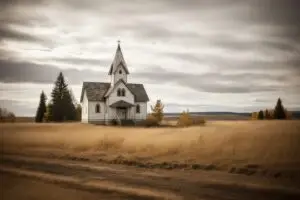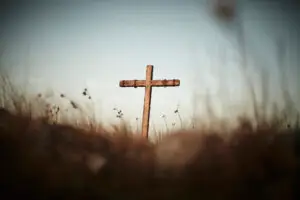A very detailed description has been given in chapters 40-42 of the dimensions of the temple and all its rooms and environs. That description follows a narrative of destruction of Gog, a scene of divine intervention in final judgment parallel to that described in Revelation 16-19. Worldly forces that glory in the plushness of their material possessions, that have provided for themselves a dazzling variety of earthly pleasures in defiance of the law of God, who glory and rival one another in earthly power are brought to a cataclysmic end by the sovereign and omnipotent intervention of the thrice-holy God. The scene is astounding for detail and thoroughness of destruction. Earthquakes and the calling of carrion eaters characterize both descriptions (Ezekiel 38:19; 39:17-20; Revelation 16:17-21; 19:17, 18). Ezekiel 39:25-29 sets forth a prophecy similar to that of chapter 37 concerning God’s gathering of “the whole house of
I. Ezekiel had been shown that the
A. He now brings the prophet back in his vision to the gate facing east in order to see the arising of the glory of God (verses 1, 2). Seeing this vision looking toward the east captured a consistent symbol as to how nature pictures an infinitely more glorious reality than anything in creation and sets in motion a chain of rich symbols. Malachi speaks of the “sun of righteousness” that rises with “healing in its wings” that is, the final consummation of all things brought about by the Lord Jesus as Son of God and Son of man, the perfectly righteous one that has provided justification and a final complete holiness for all his people gathered from all nations. These are those who have had this healing balm applied to them by the water of life flowing from the throne of God and of the Lamb that provides a constant source of life and healing: “The leaves of the tree were for the healing of the nations.” (Revelation 22:1,2)
B. In the end, the sun, as well as the moon, which provides light by reflecting that of the sun, will not be needed, for the light will be the uncreated glory of God, “and its lamp is the Lamb.” (Revelation 21:23) Ezekiel’s looking to the east means an expectation of perpetual light, “and night will be no more. They will need no light of lamp or sun, for the Lord God will be their light, and they will reign forever and ever.” (Revelation 22:5)
C. Both sound (“like the sound of many waters”) and sight (“earth shone with his glory”) are employed to indicate the sensory impressions made by the advancement of the glory of God. A true hearing of the gospel and a true sight of the divine glory become as certain to the believer as impressions made by the senses. “Faith comes by hearing,” and the truth of gospel words takes on an existential certainty to those that have those truths pressed into their conscience by the Spirit of God. John said, “And we have seen his glory, glory as of the only Son from the Father, full of grace and truth.” So does each believer se the beauty and splendor of the grace of truth intrinsic to the Son of God.
D. The vision duplicates what he had seen on two other occasions. [Ezekiel 1:24-28 when Ezekiel is commissioned to speak a word of judgment to the people. Ezekiel 10 manifests the same splendor, mystery, and energy as the first vision but shows that the Lord is departing the temple. “The glory of the Lord went out from the threshold of the house.” Now Ezekiel sees the glory of God entering the temple by the gate facing east.
God receives glory in all his works. Creation, Revelation,
God’s glory was seen first in the subjection of
E. Being brought to the inner court where all the work of sacrifice was to be done (Chapter 40:28-43), Ezekiel saw that it was from there that “the glory of the Lord filled the
II. God points to this temple as the place in which he will be separated from all the abominations of
A. Ezekiel learns from God Himself of his unalterable intention to make this temple the place of his residence among his people. This is where he will rule forever (“the place of my throne’) Where he will reside and be present among his people (“the place of the soles of my feet”).
B. He indicates by his language that in this temple we find the consummation of his covenantal promise to dwell in the midst of his people forever. See Exodus 25:8 and 29:43-46 for the intent of God to dwell with his people in the sanctifying power of his glory. This passage in Ezekiel 43 looks forward to a time when that intent is consummated by his having sanctified a people that are fully content to dwell with him and have him as their God. This reiterates what the Lord had said in 16:59-63.
C. In this appearance of the glory of God, he will make a separation from the abominations of the world and all false and hypocritical worship. Among the worst of the abominations described in Ezekiel, and there are many, is the perversity of worship revealed in chapter 8. There, the leaders, even religious leaders, of
D. The description of the dimensions of the temple created a clear distance between the false worshippers and the true. This anticipates the time when the people will be identified by their holiness and not by their ethnic origin or any mark in the flesh, but only by the worshipping in the Spirit of God, their glorying in Christ Jesus, and their lack of any confidence in the flesh (Philippians 3:3). The marks distinguishing God’s covenant people from the rest are all planted in their lives by the operations of the Spirit of God (1 John 2:18-27, 29; 3:9, 10, 24; 4:1, 2; 5:1, 4, 18.)
E. This vision is fulfilled in the inauguration of the new covenant during the ministry of Jesus (think of the implications of John 3, 4, 6, etc in terms of the new birth, true worship, the Spirit giving life). It came to further manifestation at Pentecost and in the spread of the gospel to the Samaritans and then the Gentiles. Only a believers’ church is fully consistent with this vision of the purity of God’s people. It means that the ordinances of the New Covenant are to be given to believers only {baptism and the Lord’s Supper].
III. The Temple is to be governed according to the specifications established by God. Verses 10-12.
A. This strong command gives voice to a principle called the regulative principle. In the worship of God, all that he commands we are to do; all that he forbids we must absolutely avoid; that which is not commanded is not warranted, and, therefore has no place in the worship of God no matter how wise and how spiritual or emotionally moving we may feel it to be. If God has not commanded it, then it is a matter of pure human invention and is idolatrous. Like the religious leaders in Ezekiel’s day, our minds and hearts so easily substitute our ideas for the commands of God that we find ourselves running right off the rails of pure, scripture warranted and mandated worship. We must remember that God’s commands and his descriptions of what constitutes the proper worship of Himself are most holy, “Behold, this is the law of the temple.”
B. One of the reasons for such strict enforcement of worship and such an unwavering obedience to these stipulations for the “design of the temple, its arrangement, its exits and its entrances, that is, its whole design and all its laws” is that it refers to the completed work of redemption that constitutes the full dwelling of God with his people.
This is done through Christ alone—only He was qualified to be the redeemer (see John 14:6; and Acts 4:11, 12). He must be a certain person (both God and man in one person), fully consistent with all the prophecies made about him and capable of fulfilling all the offices and types that foreshadowed him, of a blameless, spotless, faultless moral character, fully engaged with joy to accomplish that which had been commanded by God and was honoring to him.
The instructions in the wanderings of
To this reality John witnessed when he wrote, “And the Word became flesh and dwelt among us, and we have seen his glory, glory as of the only Son from [that is eternally alongside] the Father, full of grace and truth.” (John 1:14). The word for dwell could be “tabernacled” and surely reflects John’s understanding of Jesus as the fulfillment of all the measurements and purposes of the tabernacle in the wilderness and the temple in the inhabited, settled city of
Jesus referred to his own body as the temple that would be destroyed and then raised three days later (John 1:19-22). For this reason the physical temple of stone and wood and metals of all sorts would be thoroughly disassembled.
The ultimate fulfillment of this dwelling, facilitated only by the incarnation and the consequent redemptive work of Christ, is seen in Revelation 21:3 in two forms: “Behold the dwelling place of God is with man. He will dwell with them , and they will be his people, and God himself will be with them as their God.” When God revealed the specifications for that which served as a type of the incarnation and redemptive work of his Son and the final and eternal presence of God with his people in the uncreated glory of his presence, no human tampering was permitted.















